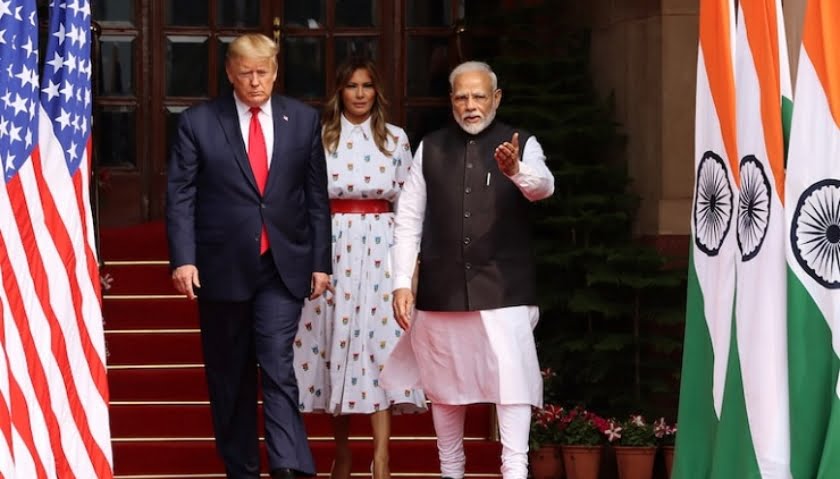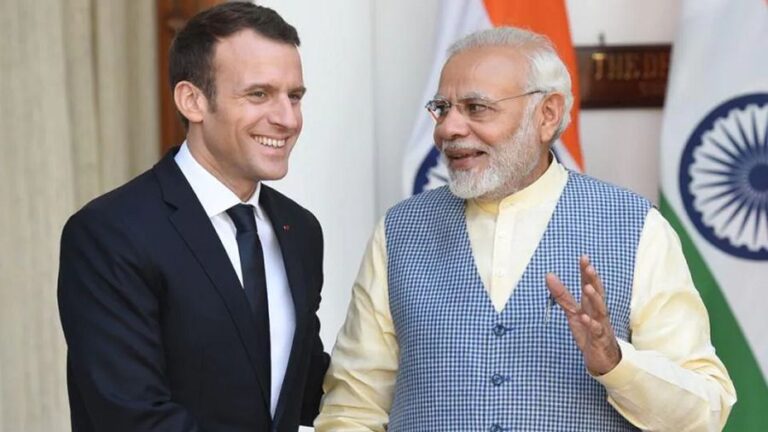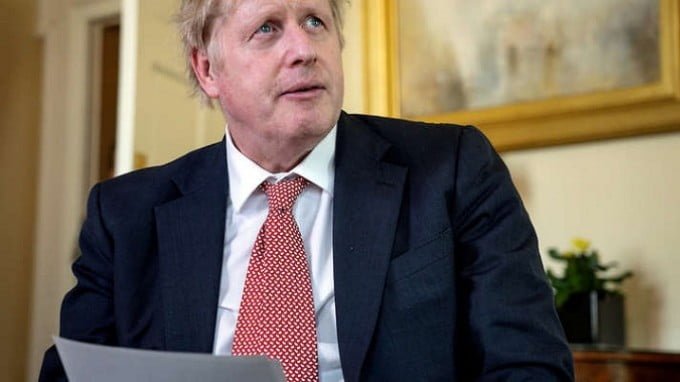Trump-Modi Bonhomie: Mostly Showmanship, Little Action!
President Donald Trump’s visit to India on February 24—the eighth of any US president—is being lauded by India’s domestic media as the greatest ever. This may be an exaggeration, but it did produce a series of arms deals and co-operation agreements in nuclear and conventional energy.
What was missing however was any large or transformative agreement to advance the US-India strategic partnership. On the contrary, it laid bare the tensions between the often-cited “shared values,” economic interests, and strategic imperatives in South Asia.
Proponents of a robust relationship with India hoped the presidential visit would continue elevating this to proverbial “new heights.” Instead, the world witnessed the consequences of growing sectarian tensions wracking the world’s largest democracy.
Trump’s visit came at a time when tensions between the US and Iran have reached their lowest point. The first-ever trilateral naval exercise between Iran, Russia and China, explosions, and the seizure of tankers in the Persian Gulf, the world’s most important choke-point of global oil supplies, have added fuel to the already burning relationship.
Accounting for a third of the world’s sea-borne oil (and a fifth of the world’s total oil exports), the Gulf links oil and gas producers in the Middle East with consumers around the globe, including those in Europe, Asia, and America. To make things worse, rampant attacks by the Yemeni Houthis on Saudi Arabia, one of which has hit Aramco’s largest processing site, have knocked out 50 percent of that country’s oil production.
Washington is wary of the emergence of China on the world stage, the resurgence of an oil-rich Russia as a major global power and the Islamic Republic of Iran’s influence in the region. Trump is seeking an alliance with India in order to counter these rising powers. His visit was timed to take advantage of China feeling political and economic pressure amidst the Hong Kong protests, the trade wars with the US and the coronavirus outbreak.
The US presidential elections slated for November also make Trump’s India visit significant. Immigrants from India are the second-largest foreign-born group in the US. There are estimated to be nearly 4 million Indian Americans, many affluent and highly educated, who mostly lean towards the Democratic Party.
Some claim that Trump’s relationship with Indian Prime Minister Narendra D. Modi has already helped boost his standing among Indian-Americans. Trump would undoubtedly want his India trip to further solidify his standing in this community. But aside from the electoral benefits both men are seeking to gain from it, here are three key takeaways from their meeting:
Economic agenda
This is turbulent time for India, Asia’s third-largest economy. It is battling a severe economic slowdown. Growth has tumbled for six consecutive quarters to a six-year low of 4.5 percent. Now the coronavirus outbreak will hinder recovery.
India has the largest number of Trump Towers outside North America, but sales are cool in an ailing luxury real estate market.
Disappointment and confusion were palpable on February 25 when the United States and India failed to meet high expectations for a modest bilateral trade deal, even as Trump and Modi predicted much bigger things to come. This disappointment seemed to be shared by the negotiators on both sides, because a deal had seemed so close, almost inevitable.
There had already been one failed attempt at a deal, which took place in the runup to the September 2019 meeting between the two leaders in New York on the margins of the UN General Assembly. However, since then many astute observers had noted steady progress, and both sides had forecast that a trade deal would be the headliner of the Trump visit to Delhi.
However it was also noted that lofty proclamations of a “very big deal,” a “comprehensive” deal, a “phase one” agreement leading to a “comprehensive” one, etc., did not quite mirror the reality on the ground. After nearly two years of negotiations, even the modest trade agreement being attempted was abandoned, reportedly because President Trump was not ready to restore India’s benefits under the US Generalized System of Preferences (GSP) tariff programme.
Hopefully, the two sides will reengage with the agenda that was on the table. But it will now be more difficult. After having conducted what was likely the most intensive bilateral trade negotiation between the two countries ever, over the space of two years, the negotiators have failed despite having a clear deadline—in this case, Trump’s visit to India. In trade negotiations, such failures are rarely reversed “promptly” (as called for in the joint statement).
If Trump remains averse to reinstating India’s GSP benefits, it is hard to see how even a phase one agreement can be concluded. This reinstatement was the quid pro quo for India making a variety of market-opening commitments, and it is reasonable for India to expect that the benefits will be granted if the US wishes to move forward.
The very existence of GSP has made it more difficult to conclude new multilateral tariff-cutting agreements within the World Trade Organization (WTO), so it remains a double-edged benefit. But if the real motivation of the Trump administration is to graduate India from the programme, which likely runs counter to the intent Congress had in legislating it, and clearly would be a deal killer.
Despite expectations, signing bilateral trade deals was never the aim of Trump’s visit. US Trade Representative Robert Lighthizer canceled a planned trip to India this month, reports Financial Times. Lighthizer had earlier dropped out of planned negotiations with Indian Commerce Minister Piyush Goyal.
Last May Trump stripped India of the Special Trade Status which exempted billions of dollars of its products from American tariffs, creating a deepening clash with India’s projections for its markets. The measure hit some Indian exports like textiles, jewelry, auto parts and agricultural commodities.
However, India did sign a deal on Tuesday to buy $3.5 billion in arms, including 24 Sikorsky MH-60R Sea Hawk multi-role helicopters for the Indian Navy and six Boeing AH-64E Apache Guardian attack helicopters for the Indian Army. This deal came through as Washington seeks a counterweight to China, as implied by Trump urging India to look at the US as its “premier defense partner”.
Energy agenda
Iraq is India’s major source of crude oil, supplying one-fourth of its needs, 26m tonnes, between April and September 2019. Saudi Arabia had traditionally filled this role, but is now relegated to second spot, exporting 20.7m tonnes to India in the first six months of this fiscal year.
The US is the world’s largest crude producer, and therefore wants a larger chunk of India’s lucrative oil market. In 1917 India bought 1.9m tonnes (equivalent to 38,000 barrels per day) of crude from the US. The Business Standard of India quoted US Energy Secretary Dan Brouillette as saying that the US is now India’s sixth-largest oil supplier. Indeed, Indian imports of US oil have increased tenfold, to 250,000 barrels per day, over the last few years.
In the first six months of the current fiscal year the US supplied 5.4m tonnes of crude to India.
Nationalist agenda
The leaders of the world’s two largest democracies should exemplify respect for democratic values and universal rights, yet Trump and Modi are pursuing dangerous, nationalistic visions at odds with their countries’ founding values.
Trump and Modi have been known to be good friends. After all, they must have something in common to be pursuing similar policies.
When Trump came to power in 2016, he made no secret of his nationalist, far-right, supremacist agenda. He imposed a travel ban targeted at Muslim countries, ripped the children of migrants away from their parents, defended white supremacists who attacked the crowd at a rally in Charlottesville, regularly demonized immigrants and told certain members of Congress (all of whom are Americans) to “go back” to their countries because they are not white.
Since being re-elected in 2019, Modi has also brazenly embraced an agenda which discriminates against Muslims and minorities. India has been at boiling point since December, when the Modi government enacted the controversial Citizenship Amendment Act (CAA), which made millions of Indian residents, mainly Muslims, stateless.
The act laid out a fast-track path to citizenship for immigrants from three neighbouring countries who are followers of all South Asia’s other major faiths. But it excludes Muslims, including those who have known no other home, despite the centuries of continuous Muslim presence in many parts of the contemporary Indian state.
Trump’s first visit to India coincided with four days of protests against the CAA in New Delhi. At least 38 people were killed, and over 200 injured, in sectarian riots not seen in decades.
Last August Modi also removed the constitutionally enshrined autonomy of Jammu and Kashmir, India’s only Muslim-majority state, whilst implementing the longest communications blackout in the history of any democracy and detaining Kashmiri political leaders.
Pramila Jayapal, an Indian-American congresswoman from Seattle, is pushing a bipartisan resolution urging New Delhi to restore Kashmir’s internet services and free hundreds of Kashmiri political and civil society leaders who have been detained without charge since August.
Senator Bernie Sanders, the Democratic presidential candidate, has posted on Facebook that “shutting out US lawmakers who are standing up for human rights is what we expect from authoritarian regimes – not from India”.
Where now?
Following another “historic” presidential visit to India long on political ceremony but short on substance—which was also marred by the tragic violence which unfolded in northeast Delhi—a central question is what comes next on the trade front? Will the two sides reengage on the negotiating agenda they have so far failed to conclude? Will they turn to other issues which had been sidelined during these negotiations, such as intellectual property rights? Will they begin the groundwork for initiating negotiations on a comprehensive free trade agreement? Or are all of the above on the table?
Both Trump and Modi wanted this visit to showcase the strength of the US–Indian strategic partnership. Any state visit by an American president would ordinarily have such an objective, but this one is challenged by Trump’s unconventional presidency and the changing attitudes of key US elites toward India.
Logically, Trump’s “America First” agenda could have radically undermined India’s traditional expectation of asymmetrical US support. That hasn’t happened to the degree it could, so Modi has every reason to be gratified that his persistent engagement of Trump has paid off — at least for now.
Trump marketed his visit on the basis that, “We’re not treated very well by India, but I happen to like Prime Minister Modi a lot.” What that actually means in concrete terms will only become clear when India sees how far it can serve US geopolitical aspirations in the region, which revolve around containing China, without raising too many of its own hopes in the process.
By Henry Kamens
Source: New Eastern Outlook







